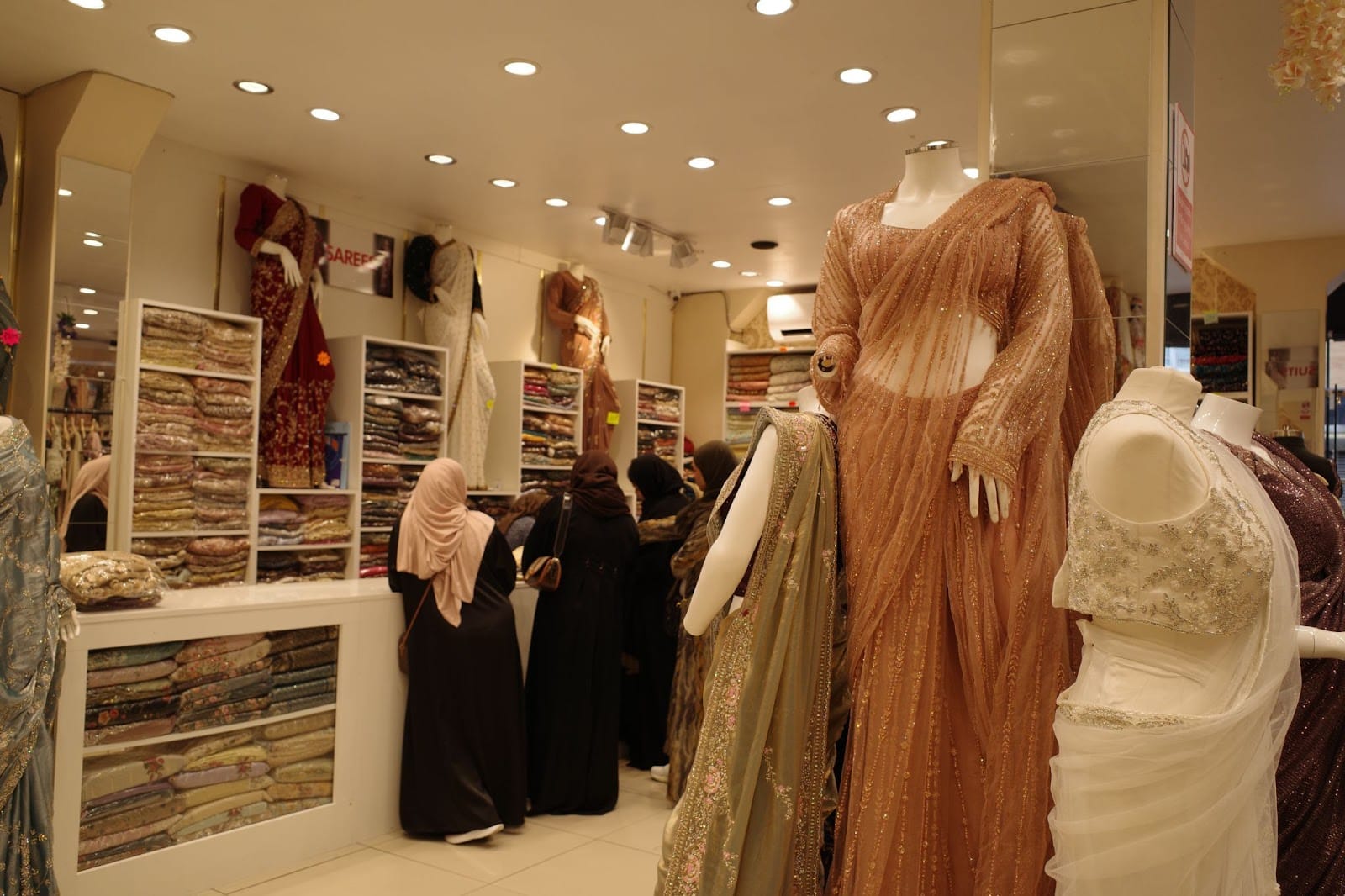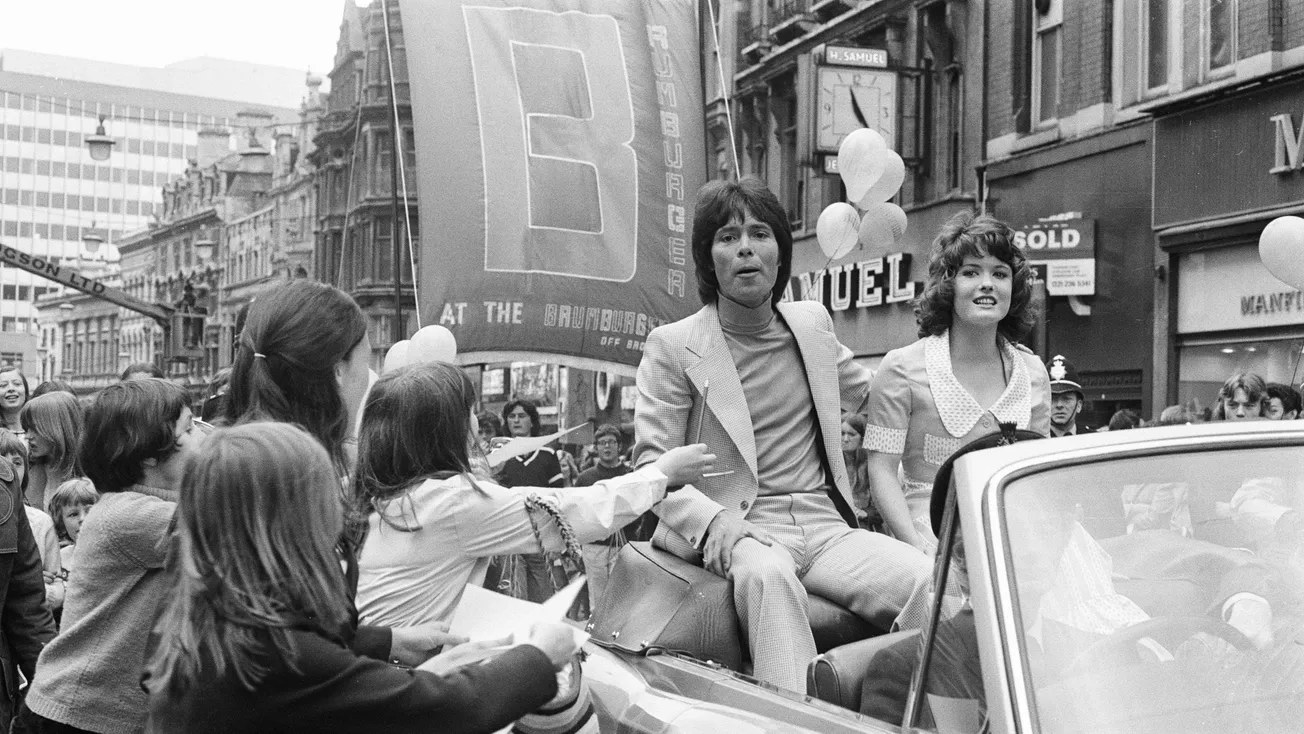By Ophira Gottlieb
It’s yet another uncomfortably warm day in Birmingham and I’m sweating my way down Soho Road. Rakesh Soni is with me, or rather walking slightly ahead of me, and he seems like the archetypal Man About Town; waving at pedestrians, knocking on shop windows to say hello, stopping to ask passersby about their weekends. All the while, he’s pointing out wedding shops to me, which account for almost every other shop on the Handsworth High Street.
There are around 150 shops on Soho Road that deal solely in the wedding industry, he tells me. Shops selling unimaginably elaborate wedding guest outfits, turbans and Kirpan swords for grooms, bright red wedding bangles for the brides, and yellowy Indian-gold jewellery for their mothers. With 150 of them, can any of them be turning a solid profit? “Oh, definitely,” says Rakesh. “A lot of the owners are driving really nice cars.”
Rakesh is the manager of Soho Road Business Improvement District — Dispatch readers may remember him from Jack Walton’s article in April, where he explained to our editor that the street’s speciality was South Asian wedding wear, and that brides-to-be came from all over the UK, and even Europe, just for the pleasure of shopping in Handsworth. That same month, the Guardian published an article on the decline of the once-great South Asian wedding shopping districts – Manchester, and Southall in London – but even they anecdotally admitted that Soho Road was thriving, despite it all. So today Rakesh is taking me on a tour of some of the shops, particularly the speciality bridalwear shops, to find out if the South Asian wedding business in Birmingham is genuinely booming — and if so (or if not), then why.
“This used to be a derelict pub. An epicentre of criminal violence, with gangs standing outside.” I’m sat with Aryan, the owner of Diya’s Bridal shop, in a pristine all-white showroom filled with thousand-pound dresses, each of them hand embroidered with hundreds of tiny, glistening beads. Up until September of 2012, this room was situated above The Barrel, a Handsworth pub which, according to Birmingham Live, had a reputation for theft, violence, drug taking, and drug dealing. Aryan claims that after a drug-related murder, the pub was forced to close down. “They had a shooting here and the council took away the licence,” he says. “So we took a risk, and got the building cheap.”

Nowadays, 215 Soho Road is a bustling, multi-story hub for bridal wear. Excited groups of women gather around clothing rails full of heavy, red dresses, chattering in Punjabi, or in thick Mancunian and Glaswegian accents. The shop sells Bengali, Pakistani, and Indian wedding dresses, and in the last few years has started to stock traditional British white gowns too. Their customers come from all over: Edinburgh, London, Rotterdam, the South of France, sometimes even the US.
“We started as a very small business,” says Aryan. “We were a 400-square-foot shop. Now we have a 10,000-square-foot store.” As business grew, Aryan and his wife expanded backwards into what was the pub beer garden, and eventually upstairs, to the room we’re in now, which is dedicated exclusively to the most expensive bridal gowns. Downstairs is for ‘party wear’ – dresses for wedding guests, that cost between £200 and £600 – but in this room, dresses will typically set you back a few thousand quid.
“In numbers, weddings are a £10 billion industry in the UK,” Aryan explains. He tells me that the average wedding in the UK costs £15-18,000, but the average Asian wedding in the UK costs £30-35,000. “That’s the stats from different magazines,” he says (having checked a few wedding websites — Bridebook, Hitched.co.uk, Mii Asian Catering — I can concur).
Aryan explains that a contributing factor to the amount people spend on their weddings is their significance as a status symbol. “There’s a lot more of a sense of competition between family and friends,” he says. As an example, he cites the famous wedding between Anant Ambani, the son of Asia’s richest man, and his girlfriend Radhika Merchant, earlier this month. The wedding was attended by everyone from media personality and socialite Kim Kardashian, to media personality and socialite Boris Johnson, and set the family back approximately $500 million. “It shows how weddings are directly connected with people’s pride,” Aryan explains. “And one of the guests was wearing a dress from our shop!”

But when I ask Aryan how business is doing, he doesn’t seem overly enthusiastic. “It’s OK,” he says. “It’s up and down.” When Diya’s first opened, there were only 12 bridal wear shops on Soho Road. Now there are 84, not to mention the other wedding-adjacent outlets that amount to the 150-shop total. “But it’s ticking over,” he adds. “It’s a thriving industry.” I ask Aryan if the increased number of shops helps with business. “You get more footfall, but at the same time you have to be more competitive,” he says. “Yes, competition is good for customers, but it’s stealing your life.”
In comparison to the brightly coloured bustle of Diya’s, Monga’s bridal shop, just a few strides down the road, has the decadent atmosphere of a posh hotel. Upstairs, the store manager, Avinash, takes a moment away from personally assisting customers to answer a few questions.
The Soho Road branch of Monga’s only opened six months ago, he explains. The brand has had a shop in Southall since 2004, and they opened a second branch in London, but ditched it in favour of Brum. However, this wasn’t a result of low footfall. “We shut in London because we had too many customers,” Avinash says. At the rate their manufacturers produce dresses, Monga’s can only serve up to 2,000 customers at once, across all branches. Despite their far more luxurious interior design, Monga’s caters to much the same demographic as Diya’s, and falls into a similar price range. “All our dresses come from India, but most of our customers are Indian, Bangladeshi, Pakistani, and Sikh.”
According to Avinash, a large number of their customers have travelled, like me, from the North West: Blackburn, Halifax, and Huddersfield. Why do they come here, of all places? “Soho Road is catching the limelight,” Avinash puts it simply. He says that Stratford Road, the other go-to South Asian shopping district in Brum, has a considerably different clientele. “I’d like to say we’re more high-end,” he says, and BID manager Rakesh agrees. “Here is… ornate,” Rakesh says. “Stratford Road is more North Indian in style. There’s more sparkles.”
A little further down the road again I reach a comparatively small and quiet little bridal shop. Arya Boutique opened only 15 months ago, and is a bespoke, specialist bridalwear shop, with a minimal selection of hand-curated stock. There behind the counter, I meet Amit (not his real name), a well-dressed man who invites me to sit for a chat.
Amit has been in the bridalwear business since 2014, starting in a tiny shop across the road from this one that he doesn’t want to name, which I assume no longer exists. “We started doing made-to-measure,” he explains. “People would come in, pick an outfit, choose a colour, and we’d take their measurements and get it custom made. That went really well.” From there, Amit and his business partners moved to a bigger shop, and made-to-measure grew in popularity and they eventually opened their own dress-making factory. “From there, we came to this shop,” he explains. But the popularity of made-to-measure has dwindled, and in this shop, it accounts for 25% of their business, the other 75% being regular retail.
“There’s two types of buyers,” Amit says. “In fact, there’s two types of people in the community. There’s the people that brought their attitude from the 60s and 70s when they first immigrated here, and they’ve held on to them.” This type of person is still under the illusion that it’s better to go wedding shopping in India, Amit tells me. “But I’ve been saying for ten years to people, it’s not cheaper in India, and you’ve got a better selection here.” He is referring to the fact that in Birmingham, different shops will curate their own particular style, whereas “in India, they’ve got everything, so you have to find what’s up your street, and you have to go out and hunt for it. And it’s very hot, very crowded.”
According to Amit, buyers in India all flock to the same few retailers in Punjab — the go-to being Frontier, a shop that has been extremely popular for South Asian wedding wear since the 70s. “If you ask anyone where they go shopping in India, it’s like a rhetorical question. Where did they go? They went to Frontier. Look I’ll ask this lady,” he says, and then converses for quite a while with a customer in Punjabi. “Yeah,” he adds eventually, “they went to Frontier.” But recently, he says, more and more customers have been realising that a trip to India is just not worth it. The price difference has reduced massively, and with the added cost of flights, these trips often end up costing more. “There used to be a massive gap,” he says, “You would save money, but now you don’t. All you do is stress yourself out.”
Amit claims that the economic climate has meant that the number of people buying wedding guest attire has reduced dramatically. According to him, the South Asian community have become a lot more comfortable with wearing the same outfit multiple times. “When we started hearing about ‘cost of living’ everywhere, I didn’t think it would hit this trade, but it has. It really, really has,” he says. “Now a lot of people are recycling outfits, unless it’s an event for someone close to them.” I ask Amit if part of this is due to the younger community being more environmentally conscious. “I don’t think they care about the environment,” he says, “I think they care about their wallet.”

He also asserts that, when customers do buy a new dress, the amount that they’re willing to spend is significantly lower. According to him, dresses in the £190 to £250 range fly off the shelves. “They become an impulse purchase,” he says. “But if a dress costs £350, suddenly people wanna try it on, they wanna send all their cousins pictures.” Another major issue for the wedding industry is that business is, ultimately, seasonal. According to Amit, the season on Soho Road runs from February until the second week of August. “After that, it’s just people running in to buy something to wear the next day,” he says. “And then by the end of August, it’s dead.”
So with all these issues, how are the shops on Soho Road managing to stay afloat? Amit suggests this is to do with prices and selection simply being worse in London. He claims that a number of customers have told him that they’d been around the Southall shops and didn’t find anything to their liking – so he went himself, and had the same experience. “I think Birmingham is getting a reputation for having a much better selection than anywhere else,” he says. Even Frontier has opened a shop in the Jewellery Quarter. “This is really good for Soho Road. Say if someone lives in Northampton, they might think ‘Shall we go to London, or shall we go to Birmingham to have a look?’ And they’ll see that on Soho Road we’ve got Kirin’s, Diya’s, Munga’s — good names where you’re certain to find an outfit.”








Comments